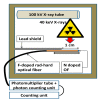Monitoring of Ultra-High Dose Rate Pulsed X-ray Facilities with Radioluminescent Nitrogen-Doped Optical Fiber
- PMID: 35590883
- PMCID: PMC9103820
- DOI: 10.3390/s22093192
Monitoring of Ultra-High Dose Rate Pulsed X-ray Facilities with Radioluminescent Nitrogen-Doped Optical Fiber
Abstract
We exploited the potential of radiation-induced emissions (RIEs) in the visible domain of a nitrogen-doped, silica-based, multimode optical fiber to monitor the very high dose rates associated with experiments at different pulsed X-ray facilities. We also tested this sensor at lower dose rates associated with steady-state X-ray irradiation machines (up to 100 keV photon energy, mean energy of 40 keV). For transient exposures, dedicated experimental campaigns were performed at ELSA (Electron et Laser, Source X et Applications) and ASTERIX facilities from CEA (Commissariat à l'Energie Atomique-France) to characterize the RIE of this fiber when exposed to X-ray pulses with durations of a few µs or ns. These facilities provide very large dose rates: in the order of MGy(SiO2)/s for the ELSA facility (up to 19 MeV photon energy) and GGy(SiO2)/s for the ASTERIX facility (up to 1 MeV). In both cases, the RIE intensities, mostly explained by the fiber radioluminescence (RIL) around 550 nm, with a contribution from Cerenkov at higher fluxes, linearly depend on the dose rates normalized to the pulse duration delivered by the facilities. By comparing these high dose rate results and those acquired under low-dose rate steady-state X-rays (only RIL was present), we showed that the RIE of this multimode optical fiber linearly depends on the dose rate over an ultra-wide dose rate range from 10-2 Gy(SiO2)/s to a few 109 Gy(SiO2)/s and photons with energy in the range from 40 keV to 19 MeV. These results demonstrate the high potential of this class of radiation monitors for beam monitoring at very high dose rates in a very large variety of facilities as future FLASH therapy facilities.
Keywords: X-rays; beam monitoring; optical fibers; optical materials; radiation effects; radioluminescence.
Conflict of interest statement
The authors declare no conflict of interest.
Figures









References
-
- Duzellier S. Radiation effects on electronic devices in space. Aerosp. Sci. Technol. 2005;9:93–99. doi: 10.1016/j.ast.2004.08.006. - DOI
-
- Dias H., Lefesvre I., Le Coeur D. Radiation effects on spatial dark current fluctuations in charge coupled devices (CCD) image sensors. SPIE Space Opt. 1994;2210:466–473. doi: 10.1117/12.188105. - DOI
MeSH terms
Substances
LinkOut - more resources
Full Text Sources
Miscellaneous

